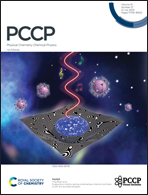Effects of Cu ratios on the C1–C6 growth mechanism on copper–nickel bimetallic surfaces†
Abstract
The adsorption and growth mechanisms of Cn (n = 1–6) on different Cu–Ni surfaces are calculated by density functional theory (DFT). The results demonstrate that Cu doping affects the growth mechanism of the deposited carbon on the catalyst surface. Firstly, the addition of Cu weakens the interaction between Cn and the adsorbed surface, which is proved by the results of density of states (DOS) and partial density of states (PDOS). The weakening of the interaction allows Cn to perform at higher proportions of Cu-doped surfaces with a behavior consistent with that in the gas phase. A comparison of the growth energies of the different pathways of Cn in the gas phase shows that the main pathway for the Cn growth is chain-to-chain (CC). The CC reaction is also the main pathway for the growth of Cn on the surfaces, which is enhanced by the doping of Cu. In addition, analysis of the growth energy revealed that C2–C3 is the rate-determining step in the growth process of Cn. The doping of Cu enhances the growth energy of this step, contributing to the suppression of the growth of the deposited carbon on the adsorbed surface. Moreover, an average carbon binding energy shows that the doping of Cu on the Ni surface could weaken the structural stability of Cn, favoring the elimination of carbon deposited on the catalyst surface.



 Please wait while we load your content...
Please wait while we load your content...